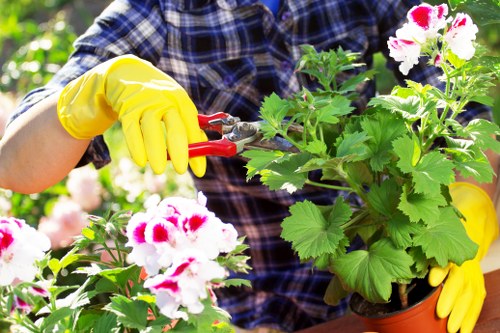Comprehensive Guide to Hedge Trimming in Lea Bridge

Maintaining a well-trimmed hedge is essential for the aesthetic appeal and health of your garden. In Lea Bridge, hedge trimming is not just about keeping your garden tidy; it's about enhancing the overall look of your property and ensuring the longevity of your plants.
Lea Bridge, located in the heart of East London, is home to numerous gardens and green spaces. Whether you're a seasoned gardener or a beginner, understanding the best practices for hedge trimming in this area can make a significant difference in the appearance of your outdoor space.
This guide will walk you through the essential aspects of hedge trimming in Lea Bridge, providing you with the knowledge and tools needed to achieve beautifully manicured hedges.

The Importance of Regular Hedge Trimming
Regular hedge trimming is vital for several reasons. Firstly, it promotes healthy growth by removing dead or diseased branches, allowing more sunlight and air to reach the inner parts of the hedge. This, in turn, prevents the growth of pests and fungi that can damage your plants.
Secondly, regular trimming helps maintain the shape and size of your hedge, ensuring it complements the overall design of your garden. A well-trimmed hedge can serve as a natural barrier, providing privacy and reducing noise from the surroundings.
Lastly, consistent maintenance makes the task easier and less time-consuming. Overgrown hedges require more effort to trim and are more challenging to shape, which can lead to uneven growth and a less appealing appearance.

Best Time to Trim Hedges in Lea Bridge
Timing is crucial when it comes to hedge trimming. In Lea Bridge, the best times to trim hedges are in late spring or early summer, after the initial growth period. This timing allows the plants to recover quickly and encourages strong, healthy growth.
Another suitable time is in late summer or early autumn. Trimming during these periods helps prepare the hedge for the colder months ahead, ensuring it remains healthy and vigorous.
Avoid trimming in late autumn or winter, as this can leave the plants vulnerable to frost damage. Additionally, refrain from trimming during the peak growth period in spring to allow the hedge to develop properly.

Essential Tools for Hedge Trimming
Having the right tools is essential for effective hedge trimming. Here are some of the must-have tools for maintaining your hedges:
- Hedge Shears: Ideal for precise trimming and shaping of hedges.
- Pruning Saws: Suitable for cutting thicker branches that hedge shears can't handle.
- Gloves: Protect your hands from thorns and rough branches.
- Loppers: Useful for cutting branches that are too large for pruning shears.
- Protective Eyewear: Keeps debris and sap out of your eyes during trimming.

Step-by-Step Hedge Trimming Process
Trimming hedges requires a systematic approach to ensure a neat and healthy result. Follow these steps for the best outcome:
- Assess the Hedge: Examine the hedge for any damaged or diseased branches and remove them first.
- Plan Your Shape: Decide on the desired shape and size of the hedge before starting the trimming process.
- Start Trimming: Begin trimming from the bottom up, removing any overgrown branches.
- Maintain Uniformity: Ensure that both sides of the hedge are trimmed evenly to maintain symmetry.
- Clean Up: Remove all trimmed branches and debris to prevent the spread of disease and pests.
Common Mistakes to Avoid

While hedge trimming seems straightforward, several common mistakes can compromise the health and appearance of your hedges:
- Over-Trimming: Cutting too much of the hedge at once can stress the plant and hinder its growth.
- Ignoring Plant Type: Different hedges require different trimming techniques. Not understanding your plant's needs can lead to poor results.
- Irregular Trimming: Inconsistent trimming can result in an uneven and unattractive hedge.
- Using Dull Tools: Dull blades can damage the plant tissues, making the hedge more susceptible to disease.

Choosing the Right Hedge for Your Garden
Selecting the appropriate type of hedge is crucial for ease of maintenance and achieving the desired look. Some popular hedge varieties in Lea Bridge include:
- Boxwood: Known for its dense growth and ability to be shaped into various forms.
- Privet: Fast-growing and ideal for creating tall, thick hedges.
- Yew: Evergreen with a rich green color, perfect for formal gardens.
- Laurel: Features glossy leaves and is excellent for privacy.
- Holly: Offers bright berries and sharp leaves, adding visual interest.

Local Regulations and Guidelines
Before undertaking hedge trimming in Lea Bridge, it's essential to be aware of any local regulations or guidelines. Some areas may have restrictions on the height and types of hedges you can plant or trim, especially if you're in a conservation area or near historical sites.
Contacting the local council or a professional gardener familiar with Lea Bridge regulations can ensure that your hedge trimming complies with all necessary rules, preventing any potential fines or legal issues.
Additionally, adhering to these guidelines helps preserve the local environment and maintain the beauty of the community's green spaces.

Hiring a Professional Hedge Trimming Service
While DIY hedge trimming can be rewarding, hiring a professional service in Lea Bridge offers several advantages:
- Expertise: Professionals have the experience and knowledge to handle various hedge types and trimming techniques.
- Time-Saving: Outsourcing the task frees up your schedule for other activities.
- Safety: Trimming tall hedges can be dangerous. Professionals have the right equipment and safety measures in place.
- Consistent Results: Ensures your hedges look neat and well-maintained throughout the year.

Cost of Hedge Trimming in Lea Bridge
The cost of hedge trimming services in Lea Bridge can vary based on several factors, including the size and height of the hedge, the number of hedges, and the complexity of the trimming required.
On average, homeowners can expect to pay between £30 to £100 per hour for professional hedge trimming. It's advisable to obtain multiple quotes from different service providers to ensure you receive a fair price.
Investing in regular professional trimming can save you money in the long run by preventing the need for extensive repairs or replacements due to neglected maintenance.
Maintaining Your Hedge Between Trims
Proper maintenance between trimming sessions ensures your hedge remains healthy and attractive:
- Watering: Ensure your hedge receives adequate water, especially during dry spells.
- Fertilizing: Use appropriate fertilizers to promote growth and enhance the plant's health.
- Pest Control: Regularly inspect your hedge for signs of pests or diseases and address them promptly.
- Weeding: Keep the base of the hedge free from weeds that can compete for nutrients.
By incorporating these maintenance practices, you can reduce the frequency of heavy trimming and keep your hedges in optimal condition.
Seasonal Hedge Trimming Tips

Spring Trimming
In spring, focus on removing any winter damage and shaping the hedge for the growing season. This is also an excellent time to train young hedges to develop the desired form.
Summer Trimming
Summer trimming helps control the growth of fast-growing hedges like privet. Light trimming encourages denser foliage and maintains the hedge's structure.
Autumn Trimming
Autumn trimming prepares your hedge for the winter months. Remove any late-season growth to prevent damage from frost and snow.
Winter Trimming
Avoid heavy trimming in winter, as this can stress the plants. If necessary, perform light cleaning to maintain the hedge's appearance.
Environmental Benefits of Well-Trimmed Hedges
Maintaining your hedges goes beyond aesthetic appeal; it also offers several environmental benefits:
- Wildlife Habitat: Hedges provide shelter and food for various birds, insects, and small mammals.
- Air Quality: Plants absorb carbon dioxide and release oxygen, improving the overall air quality.
- Noise Reduction: Dense hedges can act as a natural sound barrier, reducing urban noise pollution.
- Temperature Regulation: Hedges can provide shade in the summer and windbreaks in the winter, contributing to a more comfortable outdoor environment.
Innovative Techniques for Hedge Trimming

Modern gardening techniques can enhance the effectiveness and efficiency of hedge trimming:
- Topiary: A sculpting technique that involves shaping hedges into intricate designs and patterns.
- Power Trimmers: Electric or battery-powered hedge trimmers make the trimming process quicker and less labor-intensive.
- Pruning Standards: Implementing pruning standards ensures uniformity and promotes healthy growth.
- Integrated Pest Management: Combines biological, cultural, and chemical practices to manage pests sustainably.

Choosing the Right Time of Day for Trimming
The time of day can impact the health of your hedges. It's best to trim hedges in the early morning or late afternoon when temperatures are cooler. Avoid trimming during the hottest part of the day to reduce stress on the plants.
Additionally, ensure there's enough daylight to see clearly while trimming, helping you achieve precise cuts and better shaping.
Avoid trimming on windy days, as wind can stress the plants and make it harder to see what you're doing.

Common Hedge Types in Lea Bridge
Lea Bridge features a variety of hedge types, each with its unique characteristics:
- Boxwood: Evergreen with small, dense leaves, ideal for formal gardens.
- Privet: Fast-growing and versatile, suitable for privacy screens.
- Yew: Durable and long-lived, perfect for traditional hedge designs.
- Laurel: Large, glossy leaves that provide excellent privacy.
- Holly: Evergreen with bright red berries, adding color and interest.
Impact of Weather on Hedge Trimming

Weather conditions play a significant role in the health and appearance of your hedges:
- Rain: Heavy rain can make the hedge too slippery and increase the risk of accidents. It's best to avoid trimming during or immediately after heavy rain.
- Sunlight: Adequate sunlight is essential for healthy growth. Trimming can open up the interior of the hedge, allowing more light to penetrate.
- Frost: Late frosts can damage newly trimmed hedges. Ensure trimming is done well before the frost season.
- Humidity: High humidity levels can promote the growth of fungi and pests. Keep your hedge well-ventilated by trimming regularly.

Maintaining Hedge Tools
Proper maintenance of your hedge trimming tools ensures their longevity and effectiveness:
- Cleaning: Remove sap, dirt, and debris from the blades after each use to prevent rust and ensure smooth operation.
- Sharpening: Regularly sharpen your hedge shears and pruning saws to maintain precise cuts.
- Oiling: Apply a light coat of oil to metal parts to prevent rust and keep moving parts operating smoothly.
- Storage: Store your tools in a dry place to avoid moisture damage and prolong their lifespan.
Local Areas Near Lea Bridge for Hedge Trimming Services
Lea Bridge is surrounded by several areas that also benefit from expert hedge trimming services. Here are the closest areas:

- Marylebone West: Just a short distance from Lea Bridge, Marylebone West offers lush gardens perfect for professional trimming services.
- South Woodford: Known for its green spaces, South Woodford residents often require regular hedge maintenance.
- Edmonton Green: With expansive gardens, Edmonton Green benefits from specialized hedge trimming techniques.
- Arnos Grove: Arnos Grove's residential areas have varied hedge types, needing tailored trimming approaches.
- Lower Edmonton: Lower Edmonton homes often have older hedges that require careful trimming to preserve their structure.
- Woodford Green: Woodford Green's diverse flora benefits from professional hedge trimming services.
- Bush Hill Park: The scenic Bush Hill Park area requires regular hedge maintenance to maintain its beauty.
- Monkhams: Monkhams' modern homes feature hedges that blend contemporary and traditional styles.
- Chingford Hatch: Chingford Hatch's extensive gardens are ideal for meticulous hedge trimming.
- Hollingwood Park: Hollingwood Park's vibrant community spaces necessitate well-maintained hedges for public enjoyment.
Conclusion

Hedge trimming in Lea Bridge is a crucial aspect of garden maintenance that enhances the beauty and health of your outdoor space. By understanding the best practices, using the right tools, and possibly enlisting professional help, you can ensure your hedges remain vibrant and well-shaped throughout the year.
Regular maintenance not only improves the aesthetics of your garden but also contributes to the overall environmental health of the area. Whether you're in Marylebone West, South Woodford, or any other nearby area, investing time and effort into proper hedge trimming will yield long-lasting benefits.
Embrace the art of hedge trimming and transform your garden into a stunning showcase of nature's beauty in Lea Bridge.
Frequently Asked Questions

1. How often should I trim my hedges in Lea Bridge?
It's recommended to trim your hedges at least twice a year—once in late spring and again in late summer. However, the frequency may vary depending on the hedge type and growth rate.
2. Can I trim my hedges myself, or should I hire a professional?
While DIY trimming is possible, hiring a professional ensures precise and consistent results, especially for larger or more complex hedges.
3. What are the signs that my hedge needs trimming?
Signs include uneven growth, overgrowth blocking sunlight, dead or diseased branches, and loss of the hedge's desired shape.
4. What tools do I need for effective hedge trimming?
Essential tools include hedge shears, pruning saws, gloves, loppers, and protective eyewear.
5. How can I promote healthy growth after trimming my hedges?
Ensure your hedges receive adequate water and nutrients, protect them from pests and diseases, and maintain a regular trimming schedule to encourage robust growth.